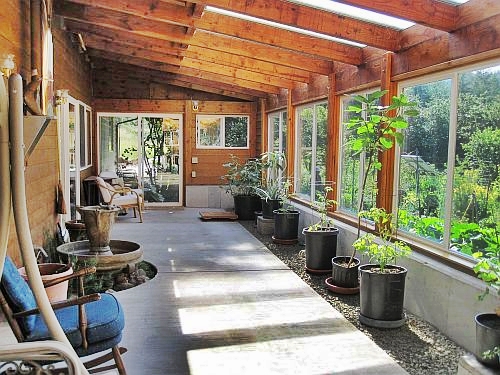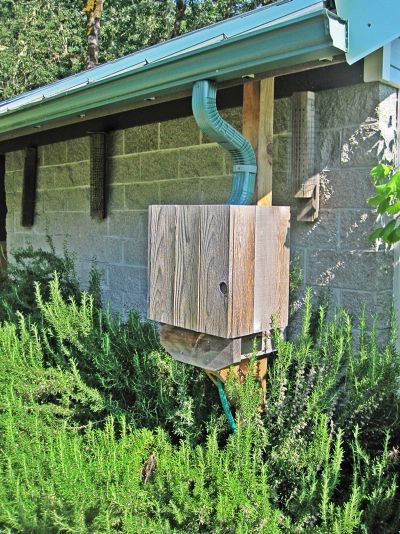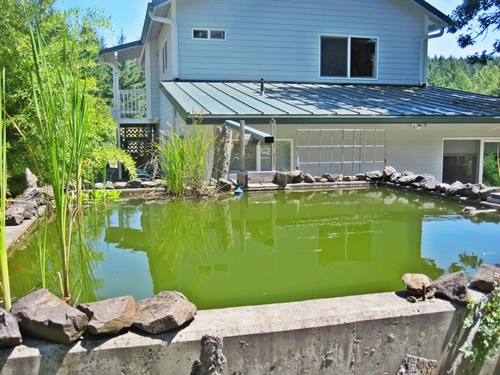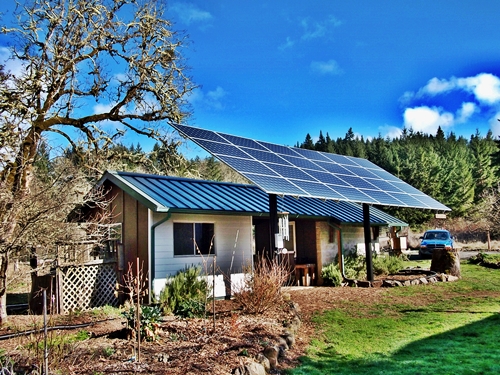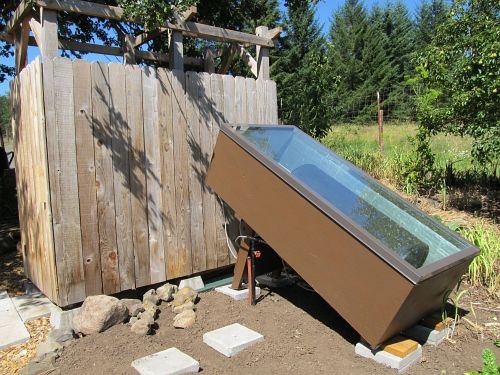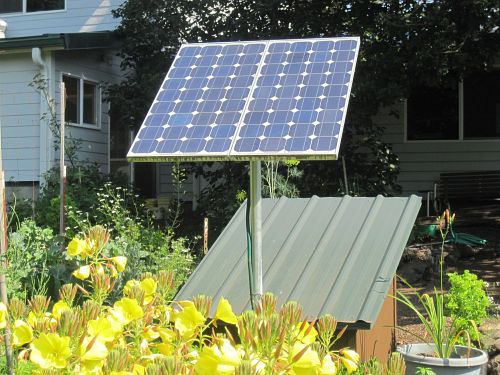Photo Gallery
“The sunroom was added to the south wall of the main residence in 2006. Its main function is to capture heat from the sun and allow it to enter the first floor of the house for space heating. Concrete floors, in sunroom and inside the house, function as thermal mass for heat storage, and the system works without additional energy inputs or moving parts. The room also functions as a solar clothes dryer, food dryer, greenhouse for early garden starts, and screened porch for sitting.”
“A simple water catchment device is provided by a downspout from a roof which deposits water into a plastic waste basket with a coupling in the bottom joined to a standard garden hose. The hose takes runoff from the roof and stores water in the ground in a nearby orchard. If ground is amended with abundant organic material, it will absorb water like a sponge and enable summer watering of the orchard to start 4 to 5 weeks later than otherwise would be necessary.
The building to which this simple water catchment device is attached is a root cellar. Root cellars have been around for centuries. We built our root cellar above ground because it was easier and used fewer materials, and prevented any possible problems with water infiltration in a heavy rainfall area. A root cellar is basically a highly insulated space that is in direct contact with the ground. At a depth of about 1-2 feet, the soil temperature stays a constant 55-58 degrees all year around. In the summer, when the outside air is warm, this 58 degree coolness is drawn up into the building and keeps it relatively cool for storing bags of grain and beans. In the winter, when it is cold outside, the 58 degree temperature is comparatively warm and keeps the air temperature inside the building very cool but always above freezing—usually between 38 and 48 degrees. After the fall harvest, the root cellar is full of things like winter squash (a real staple for us), and root crops, as well as bulk grains and legumes.”
“At Ahimsa Acres we use all of the water that comes off our roofs—more than 60,000 gallons each year just from the main residence—to water our gardens and orchards. The various water catchment systems have no moving parts and are all powered by gravity--a renewable, nonpolluting, and free source of energy. The water from the main house roof is routed to our two concrete tanks/ponds (6,000 gallons total), and from there to gardens and orchards. We have attempted to build up the soil with organic material so that it can act like a sponge and store much of the water in the ground where crops are actually being grown. This makes it possible to start watering from the well 4 to 6 weeks later in the year than would otherwise be necessary. Water is also caught from all out-buildings and redirected using simple and inexpensive systems built from recycled and repurposed materials.
“There are 24 solar electric modules mounted on two pole racks, producing a total maximum power output of 6,000 watts. The system has been in place since December 2010. The system is tied to the electric utility grid, and any power that we generate but do not need on-site is automatically sold to our utility company (Lane Electric Cooperative), thus making “green electricity” available to other utility customers. If however, at a given time, we are using more power than we are generating, the system senses this and automatically buys power from Lane Electric. When there is a power outage, the homestead has power from the solar modules in the day time and from our own battery bank at night. Thus the system is both “stand-alone” and “grid-tied.” We are presently Lane Electric Co-Op’s largest residential power generation facility, and generate on-site 95% to 100+% of the electricity that we use at Ahimsa Acres each year (this includes powering our all-electric car). Over the next 30 years, this solar generation system will prevent 146 tons of C02 (carbon dioxide) from entering the atmosphere. This is the equivalent of preventing 15,800 gallons of gasoline from being burned (according to U.S. Department of Energy).”
“In the foreground is a solar hot water heater for the outdoor shower in the background. The water heater contains a repurposed old hot water tank (outer jacket and insulation removed) that has been painted black and place in an insulated plywood box tilted toward the south to catch the sun. Rigid foam insulation inside box is foil-faced to reflect sun onto the black tank. The double pane glass cover was obtained for free from a glass dealer because it has a small scratch and could not, therefore, be sold. Runoff from shower irrigates nearby crops.”
“A pond made possible by a year-round spring enables us to store about 400,000 gallons of water for emergency use. The pond also attracts wildlife and is a peaceful setting for meditation.”
“The solar water well is powered by two 75 watt photovoltaic (PV) panels that convert sunlight directly into DC electrical current. This is what is called a PV direct system—it uses no batteries, but delivers current to the pump when sun strikes the panels (electrical flow to pump can be switched off when pumping is not needed). When the need for water is high in the summer, sunshine is abundant; when there is little sunshine in the winter, there is no need for irrigation. When in operation, the system delivers about 1.5 gallons per minute, ideal for irrigation with a weep hose made from recycled rubber tires. There is also a conventional well with pump that can deliver up to 10 gallons per minute for higher flow needs.”
Photograph credits: Various photos of Ahimsa Acres were taken by Ellen Bennett, Ty Burns, David Morales, and Lin Silvan.
